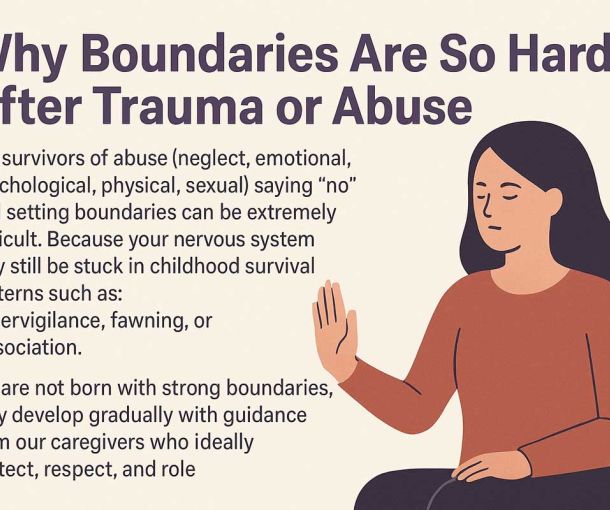Why Boundaries Are So Hard After Trauma or Abuse

For many survivors of trauma or abuse, learning to set boundaries can feel almost impossible. Whether the trauma involved emotional neglect, physical or sexual abuse, or psychological control, the effects on your nervous system can make saying “no” feel unsafe or even wrong.
This guide explores why boundaries are difficult after trauma, how this links to your body’s survival responses, and what you can do to rebuild a sense of safety and self-respect.
If you are struggling to set limits in relationships, work, or family life, trauma-informed therapy can help you recover and reconnect with your own needs.
Understanding Boundaries After Trauma
Boundaries are the invisible lines that define where you end and another person begins. They protect your emotional, physical, and psychological wellbeing.
Healthy boundaries help you:
- Feel safe and respected in relationships
- Communicate needs clearly
- Avoid over-giving or self-neglect
- Build trust through mutual respect
When trauma or abuse occurs, these boundaries are often broken, blurred, or ignored. Survivors may grow up believing their needs are less important or that saying “no” will lead to rejection, punishment, or danger.
Boundaries Are Learned, Not Innate
No one is born with perfect boundaries. They are developed through consistent caregiving, respect, and modelling. When parents or caregivers respect a child’s emotional and physical limits, that child learns that boundaries are safe.
In contrast, when a child’s limits are violated or dismissed, they may internalise messages such as:
- “My feelings don’t matter.”
- “Love means pleasing others.”
- “It’s not safe to say no.”
These early experiences create lasting patterns that can persist into adulthood until addressed in therapy.
The Nervous System and Boundary Challenges
Trauma affects the nervous system, not just the mind. When you’ve experienced chronic stress, neglect, or abuse, your body adapts by staying in a state of survival.
According to Polyvagal Theory, your nervous system constantly scans for safety or threat. After trauma, this system can become dysregulated, leaving you stuck in states of:
- Hypervigilance – always on alert for danger
- Fawning – people-pleasing to avoid conflict
- Dissociation – disconnecting from your body or emotions
Each of these survival responses makes it harder to set boundaries.
You can learn more about how your body holds trauma and how therapy can support healing in our article on Polyvagal Therapy.
Survival Responses That Block Boundaries
When your body believes safety depends on keeping others happy or avoiding conflict, saying “no” can trigger panic or shame. These are some common trauma-related patterns that interfere with healthy boundaries.
1. Fawning and People-Pleasing
The fawn response is a form of survival that develops when compliance feels safer than resistance. Survivors may:
- Constantly anticipate others’ needs
- Avoid expressing anger or disappointment
- Feel guilt for prioritising themselves
- Stay in unhealthy relationships to keep peace
This response often develops in childhood homes where love was conditional or unpredictable.
2. Hypervigilance
If you were frequently criticised or punished, your nervous system may have learned to stay on guard. You might:
- Overthink every decision
- Worry excessively about others’ reactions
- Feel unsafe when alone
- Struggle to relax even in calm environments
Hypervigilance can make boundary-setting feel dangerous, as your body associates calmness with vulnerability.
3. Dissociation and Numbing
For many survivors, saying “no” isn’t just difficult — it feels impossible because they’ve learned to disconnect from their own needs. Dissociation can manifest as:
- Feeling detached from your body
- Minimising your pain or needs
- Forgetting boundaries until they’re crossed
Trauma-informed therapy, such as Somatic Therapy, helps clients reconnect with body sensations and emotions safely.
How Childhood Abuse and Neglect Shape Boundary Development
A key aspect of trauma recovery is recognising that difficulties with boundaries aren’t a personal flaw — they are a symptom of survival adaptation.
Children who grow up in unsafe or invalidating environments often have caregivers who:
- Ignore emotional needs
- Punish independence or disagreement
- Use guilt, shame, or fear to control behaviour
- Violate privacy or personal space
Over time, this creates a distorted internal map of relationships. Instead of learning that “no” is a safe and healthy response, survivors associate boundaries with danger or abandonment.
This pattern is deeply linked to Attachment Theory, which explains how early relationships shape adult intimacy and trust. You can explore this in depth in our Attachment Theory article.
Signs You May Have Boundary Difficulties After Trauma
Recognising your own boundary patterns is the first step toward change.
You may have trouble with boundaries if you:
- Feel responsible for other people’s emotions
- Struggle to make decisions without approval
- Avoid conflict at all costs
- Often feel drained or resentful
- Say “yes” when you mean “no”
- Feel guilty for resting or taking space
- Over-explain yourself or seek constant reassurance
Awareness is empowering. Once you recognise these signs, you can begin developing new patterns with the support of a trauma-informed therapist.
Rebuilding Boundaries Through Trauma Therapy
Healing from trauma involves more than talking about the past. It requires restoring your sense of safety, choice, and control — all of which are central to setting healthy boundaries.
Many therapeutic approaches can support this process, including:
1. Person-Centred Therapy
A compassionate and non-judgmental space allows survivors to reconnect with their authentic selves. Person-Centred Therapy focuses on empathy, acceptance, and unconditional positive regard, helping clients rediscover their inner authority.
2. Gestalt Therapy and Awareness
Gestalt approaches encourage clients to notice how they feel in the present moment — tension, breath, or emotion — so they can identify where boundaries are needed. Learn more in our article on the Gestalt Cycle of Awareness.
3. Cognitive Behavioural Therapy (CBT)
CBT helps survivors identify unhelpful beliefs, such as “I must please others to be loved,” and replace them with healthier thoughts. Visit our page on Cognitive Behavioural Therapy (CBT) to see how it supports boundary work.
4. Internal Family Systems (IFS)
IFS views the self as made up of different “parts” — such as the inner child, protector, or critic. Boundaries often weaken when these parts are in conflict. Internal Family Systems (IFS) helps you listen to each part with compassion, restoring balance and self-leadership.
5. Somatic and Polyvagal Therapies
Body-based approaches like Somatic Therapy and Polyvagal Therapy help regulate the nervous system so that setting boundaries no longer feels threatening.
Trauma Recovery and the Three-Phased Model
Boundary restoration fits naturally into the three-phased model of trauma recovery:
- Stabilisation and Safety – learning regulation and self-care
- Processing and Integration – addressing traumatic memories
- Reconnection and Empowerment – rebuilding relationships and identity
Boundaries play a role in every stage. In the first phase, they help you regain a sense of control; in the final stage, they support authentic connection with others.
For more detail on this healing framework, see our page on the Trauma Recovery Three-Phased Model.
The Emotional Barriers to Boundary Setting
Even after therapy begins, emotional resistance can appear. Survivors often feel:
- Guilt for prioritising themselves
- Fear of being abandoned or rejected
- Shame for asserting needs
- Confusion about what healthy boundaries look like
These emotions are normal and temporary. Working through them with professional guidance allows you to experience boundaries not as selfishness, but as self-respect.
Steps to Begin Building Healthier Boundaries
You can start small. Healing doesn’t require perfection; it requires practice and patience.
Step 1: Notice Body Cues
Pay attention to signs of discomfort, tension, or fatigue. These sensations often signal when a boundary has been crossed.
Step 2: Practice “Pause and Check”
Before automatically saying “yes,” pause and ask yourself, “Do I really want this?” or “Is this good for me right now?”
Step 3: Start With Safe People
Choose one or two trusted people to practice asserting small boundaries, such as requesting space or saying no politely.
Step 4: Use Clear Language
Avoid over-explaining. Simple phrases like “That doesn’t work for me,” or “I need some time to think” are enough.
Step 5: Work With a Trauma-Informed Therapist
Boundary-building is a process best supported by a professional who understands trauma responses. You can begin your healing journey by contacting us to discuss therapy options.
Healing Is Possible
Boundaries are not barriers; they are bridges to safety, respect, and authentic connection. While trauma may have disrupted your sense of self, recovery can restore your inner compass.
Through compassionate counselling, nervous system regulation, and self-awareness, survivors can reclaim the ability to say “no” without fear — and “yes” with confidence.
If you are ready to start rebuilding healthy boundaries and healing from trauma, reach out to Restorative Counselling today. Our experienced therapists offer evidence-based approaches tailored to your needs, helping you move toward a more grounded and self-assured life.
Frequently Asked Questions
Because trauma conditions the nervous system to associate safety with compliance. Saying “no” can trigger fear responses rooted in past experiences of punishment or rejection.
Yes. Trauma-informed therapies such as CBT, IFS, and Somatic Therapy directly address emotional regulation and self-esteem — essential for setting healthy limits.
Every person’s timeline is different. Progress often begins within weeks as you gain awareness and tools through therapy. Full integration may take longer but leads to lasting empowerment.
Guilt is common and temporary. It often signals that you are breaking old patterns and moving toward healthier behaviour. A therapist can help you reframe guilt as growth.
You can learn more about our therapeutic approaches on our Therapies and Approaches page or contact us directly to arrange an initial consultation.









Leave a Reply